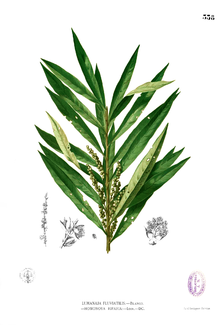Species of flowering plant
Homonoia riparia willow-leaved water croton ,[ 2] mangrove species , belongs to the family Euphorbiaceae . The plant is widely distributed through South Asian and South East Asian countries such as Cambodia , China , Indonesia , Laos , Papua New Guinea , Philippines , Sri Lanka , Taiwan , Thailand and Vietnam . It is grown in wet soil near river banks and flooded plains.[ 4]
Description
Bark - brownish
Leaves - simple, and alternate
Flowers - wind pollinated monoecious flowers and bracts sub-ovate
Height - 1–3-metre-tall evergreen shrub
Ecology - A rheophyte
Uses - medicine
Common names
The names are according to Asian Plant.net and Indian Flowers
Borneo - Bongai tidong, Parang-parang
Burma - Kyauk(a)naga, Momaka, Nyin ye bin.
Cambodia - Rey tuck.
China - Shui liu, shui yeung mui.
English - Willow-Leaved Water Croton.
India
Hindi - Sherni (शेरनी)
Marathi - Raan kaner (रान कणेर)
Tamil - Kattalari (காட்டலரி)
Malayalam - Neervanchi, Puzhavanchi
Telugu - Adavi ganneru (అడవి గన్నేరు)
Kannada - Hole nage, Niru kanigalu (ಹೊಳೆ ನಗೆ)
Sanskrit - Kshudrapashanabheda (क्षुद्रपाषाणभेद)
Java - Kajoe soebah, Keding djati, Soebah/Sobah,
Laos - Kek khay.
Philippines - Agooi, Agoioi, Agukuk,
Thailand - K(l)ai nam, Klai hin, Mai kerai, (Ta)kri nam.
Sri Lanka - Omi (ඕමි), Werawala (වැරවල)
Sumatra - Sangka, Sangkir
Vietnam - Cây rù rì nước, Rì rì, Rù rì.
References
Further reading
Yang, SM; Liu, XK; Qing, C; Wu, DG; Zhu, DY (2007). "Chemical constituents from the roots of Homonoia riparia". Yao Xue Xue Bao . 42 (3): 292– 6. PMID 17520829 .
External links

